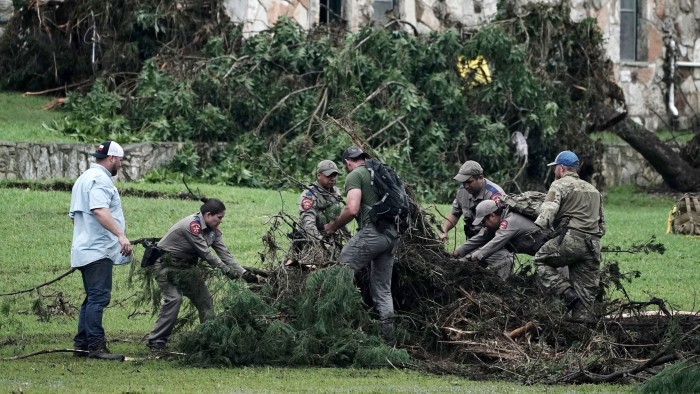Unlock the Editor’s Digest for free
Roula Khalaf, Editor of the FT, selects her favourite stories in this weekly newsletter.
The search for 11 girls missing from a summer camp in Texas continued for a third day as the death toll from flash flooding climbed to almost 70 people, including 21 children.
The Guadalupe River that runs through the Hill Country in central south Texas rose by 26ft (8 metres) in 45 minutes in the early hours of Friday, according to officials, bursting its banks and destroying roads and property, including Camp Mystic where the 11 missing girls and one counsellor were staying.
“We continue to work around the clock to reunite these families,” said Kerr County Sheriff Larry Leitha. “We will continue our search efforts until everybody is found.”
More than 400 first responders from over 20 different agencies were working in Kerr County on search and rescue efforts, in tandem with over 100 air, water and ground vehicles combing the area.
The torrential downpours that hit the Texas Hill Country over the July 4 holiday weekend claimed the lives of 59 people in Kerr County with eight more deaths reported in three other of the 20 counties affected.
“We are seeing bodies recovered all over, up and down,” said Kerrville City manager Dalton Rice. “This is a full operation.”
There has been no figure listed for the missing. More than 850 people had been rescued as of Saturday, officials said.
“It and the river running beside it, were horrendously ravaged in ways unlike I’ve seen in any natural disaster,” Texas governor Greg Abbott said on social media after his visit to Camp Mystic. “The height the rushing water reached to the top of cabins was shocking. We won’t stop until we find every girl who was in those cabins.”
City officials refused to address questions of culpability in alerting and evacuating people before the flash floods, saying their focus was on rescue and recovery efforts.
“Our goal is to rescue those in peril and find those who are lost,” said Kerrville mayor Joe Herring.
The Trump administration has slashed thousands of jobs from the National Oceanic and Atmospheric Administration, the agency that oversees the National Weather Service, leading to questions about whether staff shortages had resulted in a lack of adequate warnings.
The National Weather Service issued a flood watch for the area on Thursday at around 1pm local time, with the first flash flood warning for Kerr County issued in the very early hours of Friday.
Initial forecasts from the NWS predicted 4 inches to 8 inches (10cm to 20cm) of rain for the Hill Country. The area eventually received as much 15 inches (38cm) of rain in the deluge.
“It did not predict the amount of rain that we saw,” Nim Kidd, chief of the Texas Division of Emergency Management, said on Friday.
A flood watch remains in effect for the Texas Hill Country, including San Antonio and Austin, with warnings of possible flash flooding across central Texas.
Rain continued to fall on saturated ground on Sunday and weak winds meant developing thunderstorms with heavy downpours would move very slowly, the weather service said.
The Texas Hill Country is no stranger to floods because of its geography. The area, called “flash flood alley” is marked by narrow, serpentine valleys and steep rocky hillsides that funnel water downstream into nearby creeks and rivers.
When heavy rains come, the water cannot soak quickly into the ground because of the area’s thin layer of topsoil overlying limestone and granite.
President Trump signed a major disaster declaration for Kerr County “to ensure that our brave first responders immediately have the resources they need. These families are enduring an unimaginable tragedy, with many lives lost, and many are still missing,” he said on social media.
Scientists have warned that climate change is increasing the risk of devastating storms and intense rainfall because warmer air holds more moisture. Every one degree of warming results in an estimated 7 per cent more water in the atmosphere on average.
The world has warmed by at least 1.1C since pre-industrial times, according to the UN body of scientists’ IPCC report released in 2023, and some scientists estimate the long term trend to have already risen to more than 1.35C.
“We are going to have to adapt to more of these events,” said Hayley Fowler, professor of climate change impacts at Newcastle University in the UK. “We will need to learn how to respond to warnings, and how to safely evacuate before the flash flood.
“It will not be possible to make all of our infrastructure resilient to these catastrophically large floods, and we can expect to experience many more of these.”
Climate Capital

Where climate change meets business, markets and politics. Explore the FT’s coverage here.
Are you curious about the FT’s environmental sustainability commitments? Find out more about our science-based targets here

